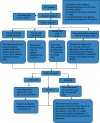The Application of the Nurse-Led Sedation and Analgesia Management in ICU after Heart Surgeries
- PMID: 35836831
- PMCID: PMC9276485
- DOI: 10.1155/2022/7706172
The Application of the Nurse-Led Sedation and Analgesia Management in ICU after Heart Surgeries
Retraction in
-
Retracted: The Application of the Nurse-Led Sedation and Analgesia Management in ICU after Heart Surgeries.Evid Based Complement Alternat Med. 2023 Jun 21;2023:9869735. doi: 10.1155/2023/9869735. eCollection 2023. Evid Based Complement Alternat Med. 2023. PMID: 37387948 Free PMC article.
Abstract
Aim: Traditional sedation management consists of doctors adjusting the dosage of sedative drugs or adding other drugs in combination according to the evaluation of nurses; the nurses then execute the orders. The nurses' passive execution in the process is not the ideal model for continuous evaluation and observation of sedation. This study aims to investigate the application and effects of nurse-provided procedural sedation and analgesia for patients in intensive care unit.
Methods: The experimental group consisted of 354 heart surgery patients who received procedural sedation and analgesia from nurses from November 2020 to August 2021. The control group consisted of 301 patients who had had heart surgery and received the traditional sedation management program from January to October 2020. The differences in levels of the sedative effect, delirium, and unplanned extubation of patients between these two groups were compared.
Results: There were no significant differences in baseline characteristics between the two groups (P > 0.05). It was found that both insufficient sedation and excessive sedation decreased in the experimental group when compared to the control group, while the appropriate proportion of sedation increased (72.41% versus 37.98%); the difference was statistically significant (P < 0.05). The incidence of delirium was lower for patients in the experimental group than for patients in the control group (37.01% versus 66.45%); the difference was statistically significant (P < 0.05). The incidence of unplanned extubation caused by patient factors was lower for the experimental group than for the control group, but the difference was not statistically significant (P > 0.05).
Conclusion: The programmed sedation scheme led by nurses can improve the sedation effect and reduce the incidence of delirium. Implications for Practice. The management team gives the sedative goal and establishes the standard flowchart. The sedation management led by the nurse according to the goal and flowchart is better than the traditional sedation management.
Copyright © 2022 Rong Lu et al.
Conflict of interest statement
The authors declare that they have no conflicts of interest.
Figures
Similar articles
-
[Study of prevention and control of delirium in ventilated patients by simulating blockage of circadian rhythm with sedative in intensive care unit].Zhonghua Wei Zhong Bing Ji Jiu Yi Xue. 2016 Jan;28(1):50-6. doi: 10.3760/cma.j.issn.2095-4352.2016.01.010. Zhonghua Wei Zhong Bing Ji Jiu Yi Xue. 2016. PMID: 26805535 Clinical Trial. Chinese.
-
[A study of using dexmedetomidine in ventilator bundle treatment in an ICU].Zhonghua Wei Zhong Bing Ji Jiu Yi Xue. 2015 Oct;27(10):836-40. Zhonghua Wei Zhong Bing Ji Jiu Yi Xue. 2015. PMID: 27132448 Clinical Trial. Chinese.
-
[Observation on safety and effects of analgesic and sedative treatment in severely burned patients during shock stage].Zhonghua Shao Shang Za Zhi. 2018 Apr 20;34(4):197-202. doi: 10.3760/cma.j.issn.1009-2587.2018.04.002. Zhonghua Shao Shang Za Zhi. 2018. PMID: 29690736 Clinical Trial. Chinese.
-
Effectiveness of dexmedetomidine versus propofol on extubation times, length of stay and mortality rates in adult cardiac surgery patients: a systematic review and meta-analysis.JBI Database System Rev Implement Rep. 2018 May;16(5):1220-1239. doi: 10.11124/JBISRIR-2017-003488. JBI Database System Rev Implement Rep. 2018. PMID: 29762314
-
Protocol-directed sedation versus non-protocol-directed sedation in mechanically ventilated intensive care adults and children.Cochrane Database Syst Rev. 2018 Nov 12;11(11):CD009771. doi: 10.1002/14651858.CD009771.pub3. Cochrane Database Syst Rev. 2018. PMID: 30480753 Free PMC article.
Cited by
-
Retracted: The Application of the Nurse-Led Sedation and Analgesia Management in ICU after Heart Surgeries.Evid Based Complement Alternat Med. 2023 Jun 21;2023:9869735. doi: 10.1155/2023/9869735. eCollection 2023. Evid Based Complement Alternat Med. 2023. PMID: 37387948 Free PMC article.
References
-
- Zhao X. M., Ye M., Li Z. Y., Li L. Z. Evaluation of the effect of eCASH concept on sedation and analgesia management in patients with mechanical ventilation in ICU. Chin Nurs Manag . 2018;18(4):533–537. doi: 10.3969/j.issn.1672-1756.2018.04.022. - DOI
-
- Ma P. L., Li Q., Liu J. T. A nationwide multi-center survey on the relationship between ICU uncomfortable experiences and sedation–analgesic strategy in mechanically ventilated patients. Medical Journal of Chinese People’s Liberation Army . 2008;33(8):957–959.
-
- Tao R. Application of Standardized Sedation Nursing in Patients with Invasive Ventilation in ICU . Shanghai, China: Fudan University; 2013.
Publication types
LinkOut - more resources
Full Text Sources


